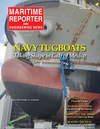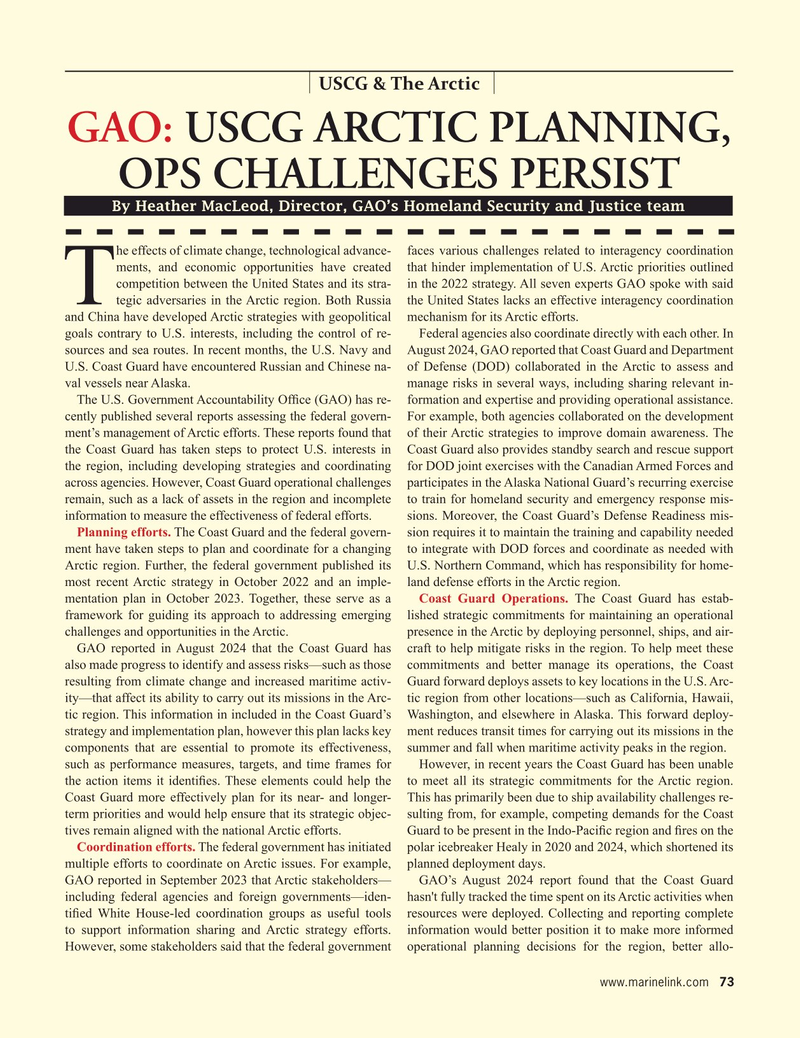
Page 73: of Maritime Reporter Magazine (November 2024)
Read this page in Pdf, Flash or Html5 edition of November 2024 Maritime Reporter Magazine
USCG & The Arctic
GAO: USCG ARCTIC PLANNING,
OPS CHALLENGES PERSIST
By Heather MacLeod, Director, GAO’s Homeland Security and Justice team he effects of climate change, technological advance- faces various challenges related to interagency coordination ments, and economic opportunities have created that hinder implementation of U.S. Arctic priorities outlined competition between the United States and its stra- in the 2022 strategy. All seven experts GAO spoke with said
Ttegic adversaries in the Arctic region. Both Russia the United States lacks an effective interagency coordination and China have developed Arctic strategies with geopolitical mechanism for its Arctic efforts.
goals contrary to U.S. interests, including the control of re- Federal agencies also coordinate directly with each other. In sources and sea routes. In recent months, the U.S. Navy and August 2024, GAO reported that Coast Guard and Department
U.S. Coast Guard have encountered Russian and Chinese na- of Defense (DOD) collaborated in the Arctic to assess and val vessels near Alaska. manage risks in several ways, including sharing relevant in-
The U.S. Government Accountability Of? ce (GAO) has re- formation and expertise and providing operational assistance. cently published several reports assessing the federal govern- For example, both agencies collaborated on the development ment’s management of Arctic efforts. These reports found that of their Arctic strategies to improve domain awareness. The the Coast Guard has taken steps to protect U.S. interests in Coast Guard also provides standby search and rescue support the region, including developing strategies and coordinating for DOD joint exercises with the Canadian Armed Forces and across agencies. However, Coast Guard operational challenges participates in the Alaska National Guard’s recurring exercise remain, such as a lack of assets in the region and incomplete to train for homeland security and emergency response mis- information to measure the effectiveness of federal efforts. sions. Moreover, the Coast Guard’s Defense Readiness mis-
Planning efforts. The Coast Guard and the federal govern- sion requires it to maintain the training and capability needed ment have taken steps to plan and coordinate for a changing to integrate with DOD forces and coordinate as needed with
Arctic region. Further, the federal government published its U.S. Northern Command, which has responsibility for home- most recent Arctic strategy in October 2022 and an imple- land defense efforts in the Arctic region.
mentation plan in October 2023. Together, these serve as a Coast Guard Operations. The Coast Guard has estab- framework for guiding its approach to addressing emerging lished strategic commitments for maintaining an operational challenges and opportunities in the Arctic. presence in the Arctic by deploying personnel, ships, and air-
GAO reported in August 2024 that the Coast Guard has craft to help mitigate risks in the region. To help meet these also made progress to identify and assess risks—such as those commitments and better manage its operations, the Coast resulting from climate change and increased maritime activ- Guard forward deploys assets to key locations in the U.S. Arc- ity—that affect its ability to carry out its missions in the Arc- tic region from other locations—such as California, Hawaii, tic region. This information in included in the Coast Guard’s Washington, and elsewhere in Alaska. This forward deploy- strategy and implementation plan, however this plan lacks key ment reduces transit times for carrying out its missions in the components that are essential to promote its effectiveness, summer and fall when maritime activity peaks in the region. such as performance measures, targets, and time frames for However, in recent years the Coast Guard has been unable the action items it identi? es. These elements could help the to meet all its strategic commitments for the Arctic region.
Coast Guard more effectively plan for its near- and longer- This has primarily been due to ship availability challenges re- term priorities and would help ensure that its strategic objec- sulting from, for example, competing demands for the Coast tives remain aligned with the national Arctic efforts. Guard to be present in the Indo-Paci? c region and ? res on the
Coordination efforts. The federal government has initiated polar icebreaker Healy in 2020 and 2024, which shortened its multiple efforts to coordinate on Arctic issues. For example, planned deployment days.
GAO reported in September 2023 that Arctic stakeholders— GAO’s August 2024 report found that the Coast Guard including federal agencies and foreign governments—iden- hasn't fully tracked the time spent on its Arctic activities when ti? ed White House-led coordination groups as useful tools resources were deployed. Collecting and reporting complete to support information sharing and Arctic strategy efforts. information would better position it to make more informed
However, some stakeholders said that the federal government operational planning decisions for the region, better allo- www.marinelink.com 73
MR #11 (66-75).indd 73 10/25/2024 10:23:55 AM

 72
72

 74
74
